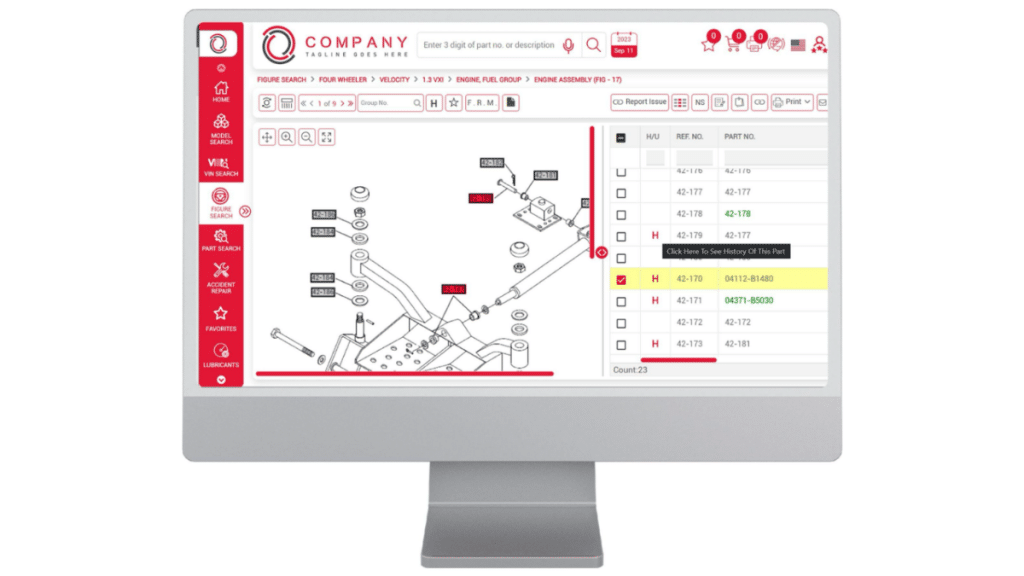The rapidly rising adoption of technology and machinery across industries worldwide is surging the use of numerous parts and components. Part identification is of significant importance so that individual parts can be tracked, monitored, replaced, and managed. Electronic parts catalog software simplifies the process of spare parts identification as well as ordering, thereby increasing efficiency for OEMs, dealers, and distributors.
A key component of any parts catalog software is the advanced search capability, whether it’s 2D or 3D parts catalog software. A robust system and efficient parts search functionality enable easy identification of desired parts with enhanced accuracy and speed. By improving search efficiency, OEMs and businesses can instantly find desired parts and place orders in a timely manner, thereby reducing downtime for consumers.
What is Parts Catalog Software?

Parts catalog software is an online and digitized version of traditional parts catalogs, with improved capabilities for advanced search. The creation of an illustrated parts catalog can be automated entirely, resulting in seamless support of large volumes of unique parts. Through the interactive parts catalog software, OEMs, dealers, and other authorized stakeholders can directly find relevant spare parts and place orders.
Electronic parts catalog software offers a wide range of advantages including cost efficiency, reliable dealer channels, boost to aftermarket sales, streamlined workflows, error-free processes, and enhanced sales opportunities. Parts catalog software is increasingly being incorporated with the latest technologies such as artificial intelligence (AI) as well as machine learning (ML) to further boost capabilities.
By streamlining the entire process, customers, dealers, suppliers, and other shareholders can be catered to with greater efficiency while the data capabilities provide insights into part performance. Based on spare part demand, forecasts are generated, identifying further opportunities to increase sales and improve product quality overall. The interactive parts catalog software is fully scalable, and the parts database can easily adapt to substantial increases in catalog offerings. Improving operations and utilizing artificial intelligence optimizes resource utilization while offering fast service, thereby improving overall cost efficiency.
Electronic Parts Catalog Software Variants
As parts catalog software becomes more commonplace, there are different variants available to meet the unique needs of OEMs and businesses. There are usually separate interactive parts catalog software options available for B2B, B2C, and B2B2C users, as well as parts catalog software adapted to different industries. Among these illustrated parts catalog options, there is further diversification depending upon visual capabilities such as 2D and 3D.
1. 2D Parts Catalog Software
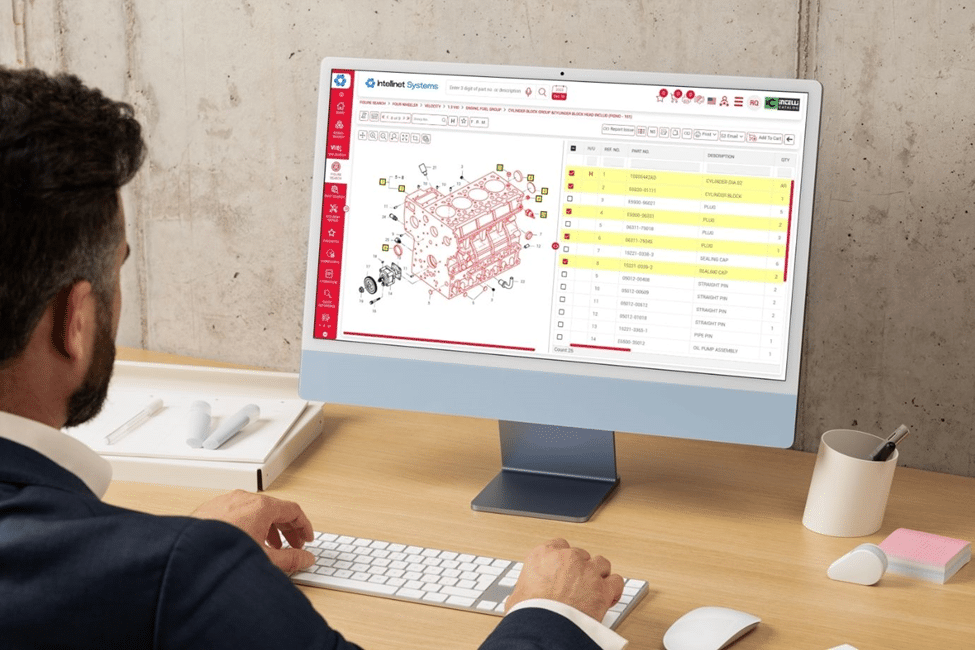
A commonly used form for parts cataloging is 2D parts catalog software where the parts database is visualized in the form of 2D images, blueprints, and schematics. Although the parts visualization is limited to two-dimensional views, generating parts in 2D views is easier and more user-friendly. Suited for any type of machinery, 2D parts visualization is an efficient solution that users can easily understand.
2. 3D Parts Catalog Software
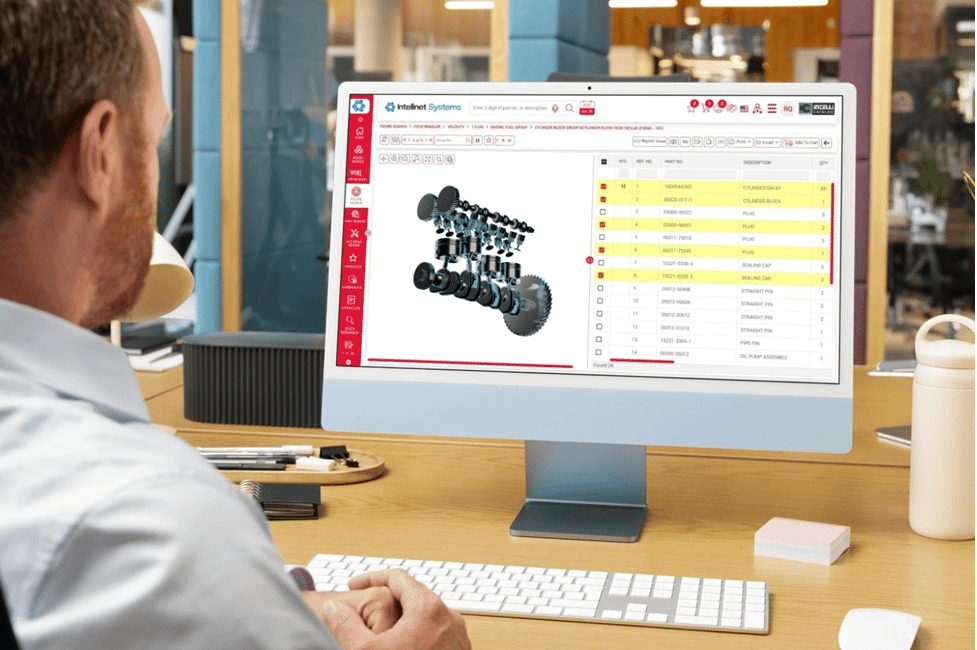
The demand and usage of 3D parts catalog software is on the rise as this type of software depicts parts in the form of a 3D model, providing more realistic parts visualization. Moreover, the 3D model is more interactive and can be rotated and zoomed to provide users with visualization from all different angles. Having a 3D parts database does provide a better understanding of parts and how they are integrated and interconnected. However, creating 3D models can be more complex and require more robust hardware and software support.
Features of Advanced Search in 2D and 3D Parts Catalog Software
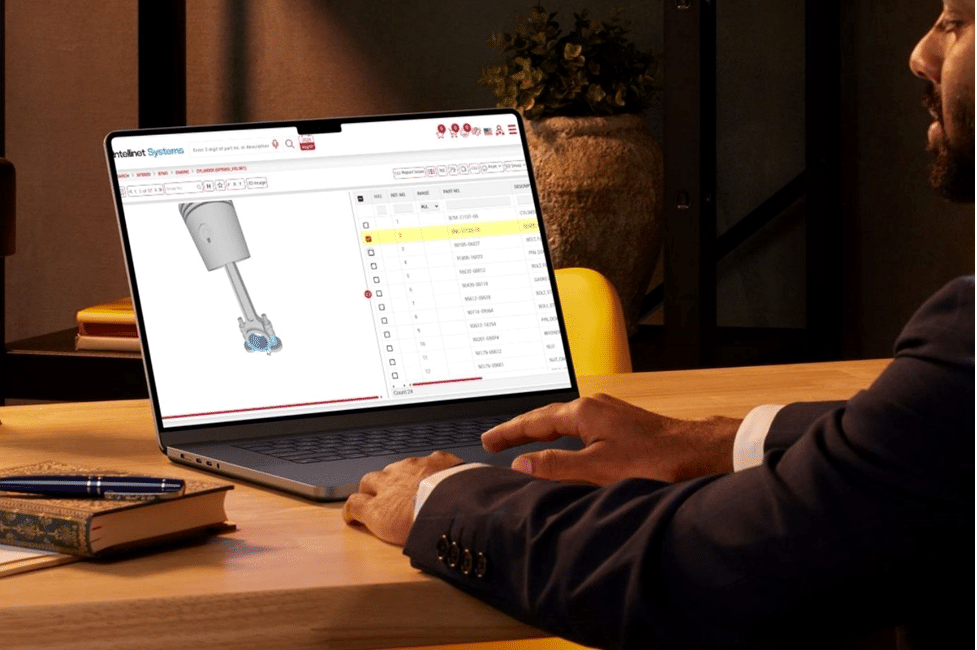
Traditional modes of spare part identification have typically been based on entering specific keywords or the serial number of a part in order to find the specific part. With minimal options for spare parts search filters, identifying a particular part could take time until the correct keyword was entered, thereby lowering the overall search efficiency. In scenarios where the part number search did not yield results, the search would have to be started again with different spare parts search filters.
Advanced search goes beyond the basic search capabilities of traditional search modes. It is further boosted by the use of technologies such as artificial intelligence and ML as well as unique algorithms and data integration. More detailed parts search filters can be applied, and a wide range of input sources can be accepted. This offers more flexibility than traditional search systems where model search and figure search are typically used.
Here are some of the advanced search features in 2D and 3D parts catalog software:
1. Advanced Keyword-Based Search
A common search option in traditional and advanced search systems is a keyword-based search, where any relevant keyword for the product can be entered. This can include anything from a part number search or even a VIN search. However, with advanced search, more complex keyword searches can be used, such as by adding Boolean operators, using multiple keywords, or wildcard searches.
2. Semantic Search
Similar to keyword-based searches, semantic searches also involve entering text, however, instead of requiring exact keywords, general text can be used. Semantic search utilizes AI, machine learning, and natural language processing to understand the intent behind text for part identification. Improving over time and usage, semantic search can accept and recognize parts from lengthier descriptions, making it immensely user-friendly for those not familiar with accurate keywords.
3. Filtering-Based Search
Although spare parts search filters are common in any catalog system, they are typically used in conjunction with keywords or some other form of search input. Filtering-based search differs due to the much wider range of filters applicable that can help narrow down spare parts enough to find the required part. These filters include attribute-based filters such as color, size, shape, material, supplier, and application. The filter-based parts search feature is particularly useful in boosting search efficiency in case of recalls or other situations where multiple spare parts need to be identified based on common criteria.
4. Visual Search
Spare parts are inherently visual, even if they are designated with a serial number or other form of identification. Visual search for spare parts is an increasingly popular spare parts search functionality due to the convenience and accuracy it provides. In this type of search, visual input is entered into the search feature of the illustrated parts catalog, and accordingly, a part is identified.
The visual input can be of various forms, depending upon the specific spare parts software and the advanced search capabilities. Some common forms of visual input include images, scanned documents, sketches, or even existing 2D or 3D files.
5. Voice Search
Voice search is another form of part identification that is being widely adopted because of its user-friendliness and convenience. In voice search, audible speech is converted into text which is then analyzed similarly to text-based and semantic searches. This spare parts search functionality uses technologies such as speech-to-text conversion, natural language processing, and artificial intelligence to search the parts database for the specific parts spoken about. The added benefit of voice search is that it can be used while on the move, in remote locations, and in locations where keyboards are not available.
6. AI-Powered Searches
Artificial intelligence is at the foundation of several types of advanced searches and is also used for AI-powered searches that deliver results that are more contextual. Similar to semantic searches, AI searches focus on understanding the intent and context behind a search while also considering past searches. It can give search suggestions and identify patterns in searching, helping users find what they are looking for as well as examine parts compatibility and recommend corresponding components to search queries.
7. Search History
Through extended use of spare parts catalog software, a significant search history is developed. Advanced parts search utilizes this history for faster and more efficient searches so that frequently searched items can be found with ease. Moreover, the AI capabilities of advanced search can be used to extrapolate and predict with greater accuracy which parts are more likely to be searched for based on past search history.
8. Integration with Additional Systems
Advanced search capabilities not only extend to the parts database of the spare parts management software but also to other systems that the software is integrated with. Electronic parts catalog software can integrate with systems such as ERP, PLM, and CAD, thereby significantly expanding the database size. With the much larger database, parts can be identified using data from the extended systems, providing enhanced parts search functionality and easier operations.
Advantages of Advanced Search
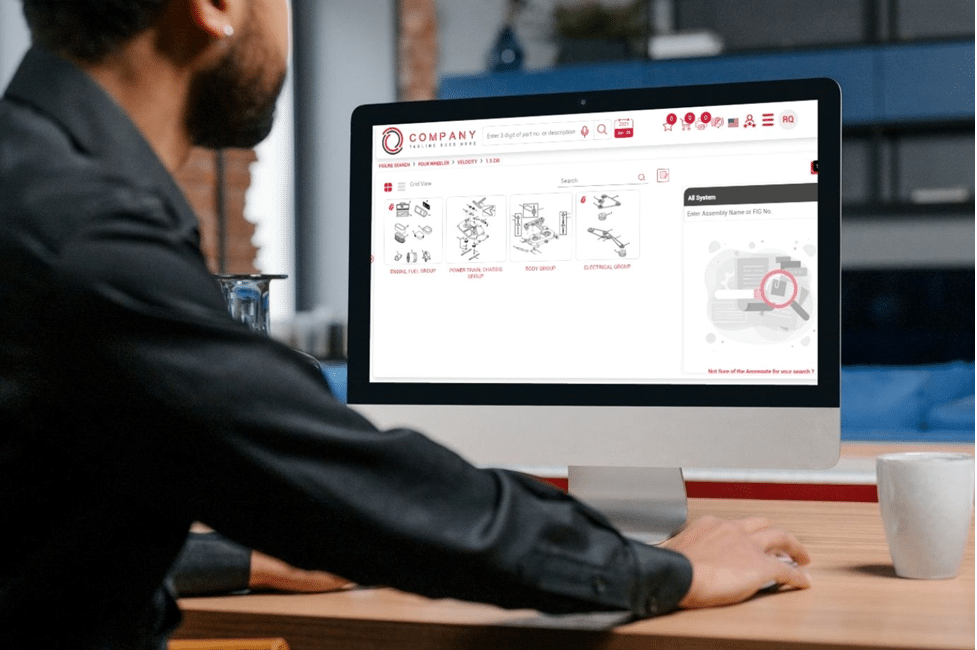
The familiarity with traditional search options and methods may cause uncertainty regarding the need for advanced search capabilities in 2D and 3D parts catalog software. However, regardless of whether the setup is for 2D parts catalog software or 3D, there are some significant advantages to advanced search. These advantages include:
1. Improved Efficiency
With advanced search capabilities, the entire process of part identification becomes faster and more accurate. By quickly finding the correct parts, subsequent steps such as ordering replacements and delivery to dealers, retailers, and customers can take place at a quicker pace, thereby improving efficiency. The faster spare parts search functionality also improves resource utilization as less time can be spent on a parts search. Data generated from the advanced search processes can also be used to improve decision-making long term.
2. Increased Cost Savings
By boosting the search efficiency, errors in ordering can be minimized for lower downtime and faster turnarounds. Accurate part identification also prevents the risk of ordering incorrect parts which adds to overhead costs. Improvements in part identification also aid in optimizing inventory management so as to reduce overstocking, while also reducing procurement and storage costs. The overall streamlined process aids in reducing labor requirements as workflows can be automated without requiring manual oversight.
3. Enhanced Customer Satisfaction
Advanced search features are immensely user-friendly and can easily be operated by dealers and even direct consumers. Their support for versatile input formats and semantic searches enables easier operations and increased accuracy in part identification. Moreover, advanced search capabilities in interactive parts catalog software aid in speeding up the entire process, providing customers and dealers with faster service and less downtime. Providing fast and accurate service helps enhance customer satisfaction and loyalty in the long term, while also improving brand image.
Conclusion
Advanced search is growing to become a vital component of any electronic parts catalog software due to its ability to quickly and accurately identify required spare parts. Advanced options for parts identification utilize cutting-edge technologies such as AI and machine learning, making it possible to conduct voice search or even visual search for desired parts. The advanced parts search functionality goes beyond standard serial number searches, providing more intuitive and user-friendly search options.
Robust advanced search capabilities are immensely versatile and can be integrated with both 2D parts catalog software and 3D parts catalog software. While 2D parts catalog solutions are more suited for simple machinery, 3D parts catalog solutions are an excellent option for more complex machinery and equipment. Beyond easy search functionalities, interactive parts catalog software aids in the overall spare parts management process, providing insights into the performance of parts and overall parts compatibility.
